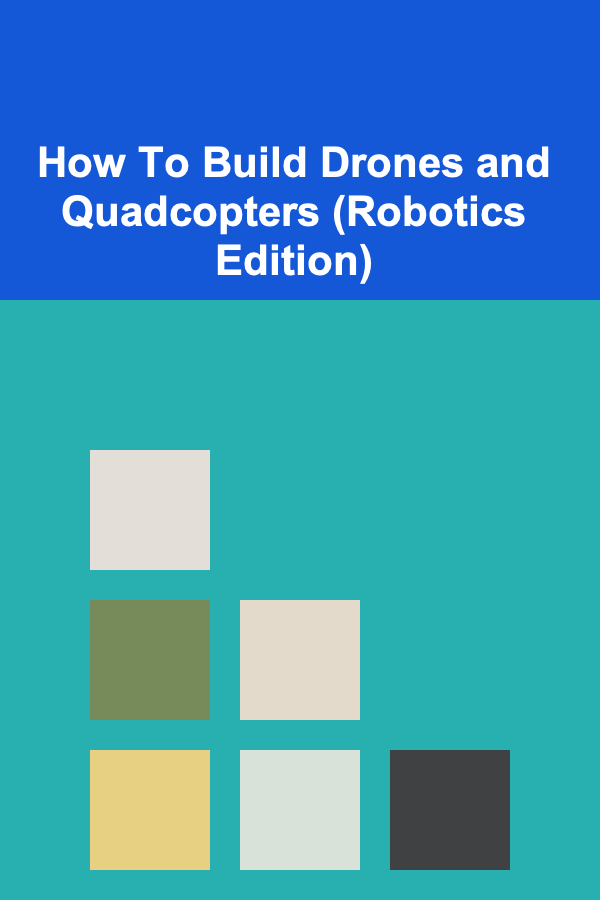
How To Build Drones and Quadcopters (Robotics Edition)
ebook include PDF & Audio bundle (Micro Guide)
$12.99$5.99
Limited Time Offer! Order within the next:

Building drones and quadcopters can be a fascinating and rewarding endeavor, blending engineering, robotics, and aerodynamics in a single project. Whether you're an aspiring hobbyist or a budding robotics engineer, creating your own drone or quadcopter allows you to gain a hands-on understanding of the technologies behind these aerial machines.
This guide aims to provide a comprehensive understanding of the process involved in building drones and quadcopters, with a focus on the technical aspects, components, and challenges. By the end of this article, you'll not only understand how to build a drone or quadcopter but also gain insight into the principles that govern their flight.
What Are Drones and Quadcopters?
Before diving into the construction process, it's important to define what drones and quadcopters are. In simple terms, a drone is an unmanned aerial vehicle (UAV), and a quadcopter is a specific type of drone that uses four rotors to achieve lift and maneuverability. Quadcopters are the most common type of drones used for consumer, commercial, and research purposes.
The key difference between quadcopters and other types of UAVs (such as fixed-wing drones or helicopters) lies in the rotor configuration and flight dynamics. Quadcopters rely on their four rotors, each spinning at different speeds to maintain balance, stability, and control. The flight of a quadcopter is managed by varying the speed of individual motors, which creates the necessary lift and movement.
Understanding the Basics of Flight
To successfully build and fly a drone or quadcopter, you need to understand the fundamental principles of flight. Quadcopters, like all aircraft, rely on four forces to control their movement: lift, thrust, drag, and weight.
- Lift: This is the force that counteracts gravity and allows the drone to stay airborne. It is generated by the rotors.
- Thrust: Thrust is the forward or upward force that propels the drone. In quadcopters, thrust is generated by the motors and rotors.
- Drag: This is the resistance encountered as the drone moves through the air. Drag works against thrust and can slow the drone down.
- Weight: The weight of the drone pulls it downward and is counteracted by lift.
Understanding how these forces work together is crucial for optimizing the design and flight performance of your drone.
Step 1: Choosing the Right Components
The first and most important step in building a drone or quadcopter is selecting the right components. The quality and compatibility of these parts will directly affect the performance of your drone.
1.1 Frame
The frame is the structure that holds all the components together. It must be lightweight yet durable, as it needs to withstand the forces encountered during flight. Popular frame materials include:
- Carbon Fiber: Known for its strength and lightness, carbon fiber is a popular choice for drone frames. It's also highly resistant to wear and tear.
- Plastic: Often used for beginner drones, plastic frames are affordable but can be less durable than carbon fiber.
- Aluminum: A balance between strength and weight, aluminum is sometimes used in more advanced drone frames.
The size of the frame depends on the size of the drone you want to build. A standard quadcopter frame will typically have a diagonal measurement of 250mm to 450mm, but this can vary based on your design.
1.2 Motors
The motors are responsible for spinning the rotors and generating lift. For quadcopters, you'll need four motors -- one for each rotor. When choosing motors, you must consider the following:
- Size and KV Rating: The KV rating of a motor indicates its speed. Higher KV motors spin faster but provide less torque, while lower KV motors are slower but offer more torque. Choose the appropriate KV rating based on the size of your drone and the weight it will carry.
- Brushless vs. Brushed: Brushless motors are more efficient and longer-lasting than brushed motors, which makes them ideal for drones. Brushless motors also provide smoother flight control, which is essential for stability.
1.3 ESC (Electronic Speed Controller)
The ESC is responsible for controlling the speed of the motors by regulating the power sent to each motor. Each motor on the quadcopter will require its own ESC. When selecting ESCs, ensure that they are compatible with your motors and capable of handling the required power.
1.4 Propellers
Propellers are the primary components responsible for generating lift. The size and pitch of the propellers will affect the overall efficiency and flight characteristics of the drone. Larger propellers can move more air and generate more lift, while smaller propellers are better for agility and speed.
Propellers are typically made from plastic, carbon fiber, or other lightweight materials. It's important to choose propellers that match the motor and ESC specifications to ensure safe and efficient flight.
1.5 Flight Controller
The flight controller is the brain of the drone, responsible for stabilizing the aircraft and maintaining control. It takes input from sensors, such as accelerometers and gyroscopes, to adjust the speed of the motors and keep the drone stable during flight. Some of the most popular flight controllers include:
- Naze32: A widely used flight controller for quadcopters, known for its reliability and support for various sensors.
- Pixhawk: A more advanced flight controller that offers additional features, including GPS integration and autonomous flight modes.
- KK2.1.5: A basic flight controller that's user-friendly and suitable for beginner drones.
1.6 Battery
The battery provides the power necessary for flight. The most common type of battery used in drones is the LiPo (Lithium Polymer) battery, known for its high energy density and lightweight design. When choosing a battery, consider the following factors:
- Voltage (V): The voltage of the battery affects the overall power and thrust of the drone.
- Capacity (mAh): The higher the capacity, the longer your drone can stay in the air.
- Discharge Rate (C): This indicates how quickly the battery can deliver power to the motors. Ensure the discharge rate matches the requirements of your motors and ESCs.
1.7 GPS and Sensors
For more advanced functionality, such as autonomous flying and precise navigation, you can equip your drone with a GPS module. Additionally, sensors such as barometers, magnetometers, and range finders can improve flight performance by providing real-time data about the drone's altitude, orientation, and surroundings.
Step 2: Assembling the Drone
Once you've gathered all the necessary components, it's time to start assembling your drone. The process typically involves the following steps:
2.1 Mounting the Frame
Start by assembling the frame. Ensure that all parts are securely attached, as this will form the base for all your other components. Most drone frames come with instructions, but if you're using a custom frame, make sure to measure and align everything properly.
2.2 Installing the Motors
Next, install the motors onto the frame. Motors are usually attached to the frame using screws, and it's important to ensure they are oriented correctly. For a quadcopter, you'll need to place the motors in specific positions to achieve balanced flight.
2.3 Wiring the ESCs
The ESCs need to be wired to the motors and flight controller. Each ESC should be connected to one of the four motors. Additionally, the ESCs need to be connected to the flight controller, which will control the motor speeds.
2.4 Attaching the Propellers
Once the motors and ESCs are in place, attach the propellers. Be sure to install them in the correct orientation (clockwise or counterclockwise) to ensure proper lift generation. Tighten them securely to prevent them from coming loose during flight.
2.5 Installing the Flight Controller
Mount the flight controller on the frame, usually in the center of the drone. The flight controller should be aligned with the frame to ensure proper stabilization. Most flight controllers come with mounting pads or screws to make installation easier.
2.6 Connecting the Battery and Wiring
Finally, connect the battery to the ESCs and flight controller. Double-check all the connections to ensure they are secure and correctly positioned. A loose connection can result in power loss or instability during flight.
Step 3: Configuring the Software
Once the drone is assembled, you'll need to configure the software that controls the flight. This usually involves installing firmware on the flight controller and calibrating the sensors.
3.1 Installing Firmware
Most flight controllers come with proprietary firmware or can support open-source flight software like Betaflight or ArduPilot. Install the appropriate firmware on the flight controller using the software provided by the manufacturer.
3.2 Calibrating the Sensors
Before flying the drone, it's essential to calibrate the accelerometer, gyroscope, and compass. This ensures that the flight controller has accurate data to stabilize the drone. Calibration typically involves holding the drone in specific positions while connected to your computer and running the calibration process through the flight software.
3.3 Setting Up Flight Modes
Configure the flight modes to suit your needs. Basic flight modes include:
- Stable Mode: The drone automatically stabilizes itself when you release the controls.
- Acro Mode: Provides manual control without automatic stabilization, suitable for advanced pilots.
- GPS Hold: Uses GPS to hold the drone's position in the air.
3.4 Testing
Before taking your drone outside, perform an indoor test to check the basic functionality. Make sure that the motors spin properly and that the drone responds to control inputs.
Step 4: First Flight
Once the drone is fully assembled and calibrated, it's time for the first flight. Start by flying your drone in an open space, free from obstacles. Begin with low throttle and practice basic maneuvers such as hovering, turning, and controlling altitude. It's recommended to use a simulator before attempting your first flight to get a feel for how the controls work.
Conclusion
Building your own drone or quadcopter can be a fulfilling project that combines various aspects of engineering and technology. By understanding the components and principles behind drone flight, you can create a functional UAV tailored to your specific needs. Whether you're flying for fun or developing more advanced autonomous systems, the process of building a drone will deepen your understanding of robotics and aviation.

How to Create a Meeting Checklist for Cross-Functional Teams
Read More
How to Create a Smart Storage System for Your Laundry Room
Read More
How to Make the Most of Family Movie Nights with Interactive Games
Read More
The Ultimate Guide to Finding Free or Low-Cost Educational Resources Online
Read More
How To Understand Quantum Computing for Drug Development
Read More
How to Find Adventure in the Patagonian Wilderness
Read MoreOther Products

How to Create a Meeting Checklist for Cross-Functional Teams
Read More
How to Create a Smart Storage System for Your Laundry Room
Read More
How to Make the Most of Family Movie Nights with Interactive Games
Read More
The Ultimate Guide to Finding Free or Low-Cost Educational Resources Online
Read More
How To Understand Quantum Computing for Drug Development
Read More